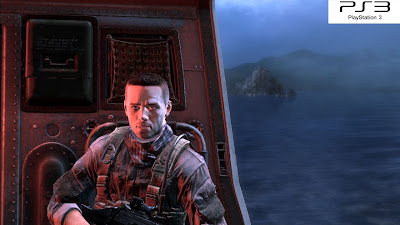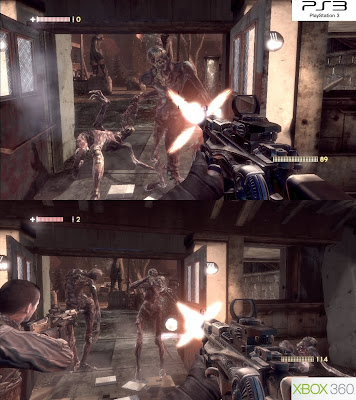When talking about the game it’s hard not to mention other similar titles such as Bioshock, and Wolfenstien, both of which Singularity seems to take influence from, especially with regards to its dark and gloomy atmosphere and use of warped human-engineered technology. You can also feel touches of Valve’s masterpiece Half-Life 2 flowing through some of the experience too, mostly arriving whenever that time-dilation device is in hand.


Using the popular Unreal Engine 3, Raven games have actually created a technically competent release, one that actually fairs extremely well on both platforms. Usually the PS3 is the one to suffer with titles using the Unreal Engine, often having significant cuts in rendering resolution and alpha buffer size for transparencies and other such graphical effects. But not so with Singularity, which demonstrates that it is possible to almost achieve parity when taking the time and care to do so.
In motion both versions look pretty much identical. Or rather, most of the time they ‘do’ look identical. It’s hard to tell them apart other than from the occasional slightly more jagged edges on PS3, and the loss of a few specular effects in areas with lots of water. That and some performance issues are the only things separating the two versions apart.

Singularity is rendered in 720p (1280x720) on both Xbox 360 and on PS3. As per usual with games released for both formats, and those using the UE3, 360 owners get 2xMSAA while the PS3 gets no anti-aliasing of any kind.
However this isn’t quite as bigger deal as you might think. When in motion the use of 2xMSAA on 360 does very little if anything to set it apart from the PS3 game. The reason behind this is that the AA used in the 360 version is selective. It’s only applied on certain objects and in certain areas in specific conditions, meaning that most of the time it’s barely there at all. We’ve seen the same thing before with the UE3 on both Gears Of War 1&2 which only apply AA on objects without movement, or when you are standing still.
Seeing as the game features very little in the way of high contrasting edges the PS3 version rarely looks to display any more jaggies than the 360 game, and any differences are only really visible when both versions are put side by side in screenshots. So whilst 360 owners can boast about having AA included, in reality it’s more of a checkbox feature here than a real benefit to the graphical quality of the game.


Moving on we can see that texture detail is like for like across both platforms, as is the game’s use of texture filtering. AF levels appear reasonably good, though not exceptional, and just seem to get the job done of displaying clean-ish textures in the distance. Usually it’s the PS3 which commands the advantage in this area with RSX’s larger amount of texturing units, but this is clearly not the case here. In fact it’s the 360 which shows a greater level of AF than usually seen with many multiplatform titles, normally satisfied with going in for a bilinear or trilinear approach.
One area in which the PS3 version does edge ahead of the 360 build however, is with regards to the game’s lighting and shadowing system, which looks slightly more refined. Texture details and certain graphical effects tend to be accentuated, standing out almost like there is some kind of subtle AO going on, even though we know that there isn’t. Shadows are also subtly more defined, creating an added sense of depth to the image.

In terms of particle effects and alpha buffers both versions seem to look identical, with no lower resolution discrepancies to be found anywhere in the PS3 version. The striking similarity between the two can be seen in the screenshot above, where even when a large part of the screen is filled with effects the PS3 still manages to stay par the course along with the 360 every step of the way.
This is in start contrast to Bioshock 2 in which the PS3 build featured lower resolution effects for smoke, fire, water, and electricity, noticeably reducing the game’s overall image quality. Thankfully, for the most part, the same thing doesn’t happen here.

Interestingly the same cannot be said for the use of specular effects and normal maps. Here it’s the 360 build that commands a small but visible lead over the PS3 game. All normal maps in areas that feature water or wet surfaces are dialled back on PS3, and in turn lack the same levels of depth and intensity compared to what you can see on 360. Some areas feature lower resolution normal maps too, further reducing overall quality.
The above screenshots clearly shows off the differences between the two versions. Notice how on the walls in particular the normal mapping is less obvious on PS3, and that the effects creating their shiny wetness are clearly in a slightly lower resolution compared to the rest of the scene.
This is perhaps the biggest difference between the two outside of the PS3’s better use of lighting and shadowing, and the 360’s small commanding lead in overall performance.

So far nether version has really come out on top, with the PS3’s superior lighting being countered by the higher resolution normal mapping found in the 360 game. Instead it’s down to performance to perhaps provide us with the clearest look as to which version is technically superior. After all, frame rate issues and screen tear tend to have far more of an impact during gameplay than some cutback visual effects.
Not so surprisingly the differences apparent here aren’t all that noticeable. In the end the PS3 game does demonstrate more in the way of both screen tear and framerate drops, but also does so more subtly than you might think. Most of the extra tearing that occurs in the Sony version is only really present in the overscan area of the screen, meaning that most people will never see it. Another thing is that although the PS3 game does indeed fare slightly worse than the 360 one overall, the same issues are also present in that version too, just to a lesser extent.
Both versions start off running at 30fps and try to attempt to remain v-synced for the duration. However it is clear that the PS3 losses v-sync more often than the 360 casuing a small increase in screen tear. Surprisingly, even when the PS3 build does lose its command of this, the effect has no bearing on framerate whatsoever. Usually the way it seems to work is that the PS3 version substitutes a consistent framerate in order to maintain v-sync and in turn suffer from less screen tearing as a result. Whilst on 360 most developers favour the approach of dropping v-sync in order to keep a higher framerate.
Here we have a situation where we get more tearing and greater framerate drops on PS3 and less on 360. However, despite this there is very little in between the two when simply playing the game without looking for these things. Yes, some differences are subtly noticeable, but at the same time they are not game breaking or at all intrusive for that matter. Arguably the 360 does maintain a small lead in terms of performance, a lead that in the grand scale of things does very little in making it definitively superior overall; much like the build’s inclusion of anti-aliasing.

In conclusion Singularity is pretty much equal on both platforms. The PS3 game benefits from having slightly better lighting and shadowing, whilst 360 owners get better normal mapping and a small lead in commanding performance. When it comes down to it though, in motion you’d be hard pressed to tell them apart, and many of the things pointed out here I could only see when lining up the games side by side when standing still – not something you’d normally be doing when playing.
Your purchasing decision then solely comes down to which controller layout you prefer, and which of the two systems you like to use the most. Anyone looking to try out the game shouldn’t have any concerns as to which version they choose to buy, as it’s pretty much identical across the board.

I believe you're mistaken with the lighting/shadow thing. Playing and comparing both myself, the lighting/shadowing are the same on both consoles.
ReplyDeleteYou're seeing a difference in gamma settings on both boxes relative to your TV. It makes the effect a lot more pronounced on PS3 only because the gamma is darker. You can set your 360 levels and your TV to darker gamma and you'd get the same effect.
Do you really want to change your TV setting every time you put in a different game/console? Let's not be pernickety just for the sake of arguing =P
ReplyDeleteGood idea on the gamma setting. You wouldn't have to change the TV, just the gamma in the game's video options one time.
ReplyDeleteI'm struggling to see the normal mapping difference here. In the fifth comparison shots I can't see the shiny wet wall surface on either of them. Is it the poster on the left? Most noticeable thing to me is the wire fence.